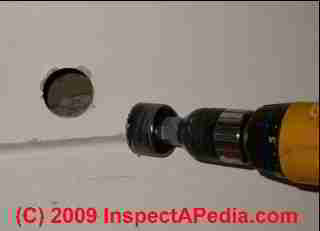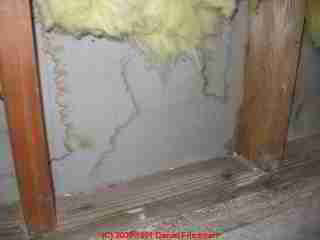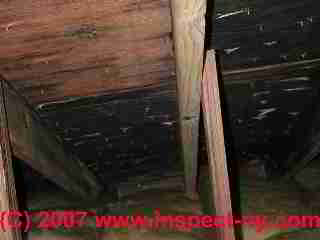 Attic & Roof Mold Contamination
Attic & Roof Mold Contamination
How to Find & Test for & Remove Mold in Attics
- POST a QUESTION or COMMENT about the causes, risks, and cures for attic or roof cavity mold contamination.
Attic & roof mold contamination causes & cures:
Not all attic mold is toxic or harmful. It is also not the case that all attic mold needs to be cleaned or removed. It is not the case that all attic mold is going to enter the living area or otherwise be a problem for building occupants.
On the other hand some attic mold contamination can enter air handling equipment, ductwork, or occupied space and can be a risk to occupants. How do we determine the difference between actionable attic mold and cosmetic mold? What must be done to clean up or remove attic mold contamination, and how do we prevent attic mold growth?
This article series on attic and roof mold contamination gives detailed step by step procedures and advice on how to find, test for, remove & prevent future mold contamination in building attics and roof cavities.
InspectAPedia tolerates no conflicts of interest. We have no relationship with advertisers, products, or services discussed at this website.
Is attic mold a health risk or indoor air quality problem?
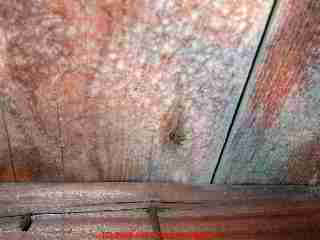
Toxic attic mold: The photo at the left was identified as a toxic mold that probably should be removed, although the ease of movement of mold spores from an attic down into a living area varies widely from building to building.
Uncertain attic mold: The photo at the very top of this page shows where you may find mold growing on the attic side of ceiling drywall, particularly below roof leaks or in areas of ice dam leaks at a building eaves.
Article Contents
We pulled back the fiberglass insulation to expose this small area of mold growth. What about the white mold-suspect material observed on the rafters?
Is that mold?
If so is it a problem?
The answer is, "it depends."
In addition to testing to see what this material is (presuming there is a large area of it), we'd also evaluate the chances of particle movement between the attic and the living space before deciding on an appropriate approach to this moldy attic.
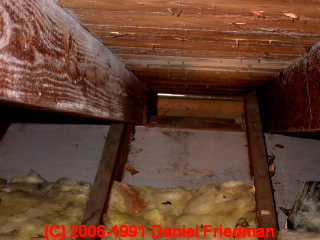 This article discusses attic mold in the following order:
This article discusses attic mold in the following order:
- How to evaluate the risk of toxic (or harmless) attic mold
- Where to look for mold in a building attic
- When is it necessary to tear off a roof to deal with attic mold?
- When to use or not use media blast and use encapsulants for attic mold
- Should attic mold even be removed? Are there other more important mold reservoirs to clean up first?
- Which insulation is most or least likely to harbor non-visible mold
- How can moldy air move downwards from an attic into occupied building space?
It is simply not the case that all attic mold is toxic. It is not the case that all attic mold is harmful.It is not the case that all attic mold needs to be cleaned or removed. It is not the case that all attic mold is going to enter the living area or otherwise be a problem for building occupants.
It is however the case that attic mold indicates damp conditions or leaks and therefore some further investigation or thought are in order.
Be sure to use the links at the end of this article to review other examples of mold found in attics on tongue-and-groove roof sheathing, brown mold and very dark brown, black-looking mold on attic plywood, and the risk of hidden mold in attic insulation.
then ATTIC MOLD, WHAT IT LOOKS LIKE
Also see our photo guide to finding attic moisture and mold
at ATTIC MOISTURE or MOLD - how to Detect & Correct Attic Condensation, Frost, Ice Dam Leaks & Attic Mold
How to Evaluate the Risk of Toxic Attic Mold
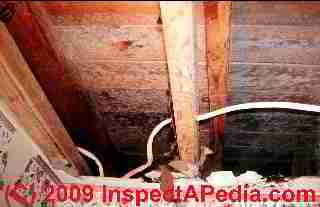 Here are some comments about air and particle movement in buildings and thus the chances that attic mold
will be transported from that area into the living space.
Here are some comments about air and particle movement in buildings and thus the chances that attic mold
will be transported from that area into the living space.
- Air and particle movement
in buildings tends to be up and out from lower floors to upper floors to attic. - There is not such easy particle movement downwards from an attic into a building.
- Attic mold is less likely to be the significant mold problem source in a building than moldy lower areas such as basements, crawl spaces, or wet building cavities.
- Important exceptions to this normally-upwards movement of indoor air currents
do occur however:- Attic or whole house fans: When a whole house vent fan is used and the attic venting is inadequate - resulting in a pressurized attic.
When the fan is operated, attic particulates, including mold, insect allergens, rodent fecal debris, mite fecals, bird droppings, dust, particles (Histoplasmosis risk), may be blown downwards into the living area or into attic-mounted HVAC equipment. - Moldy attic knee wall areas: A moldy attic kneewall space adjacent to a bedroom on the upper floor of a cape cod or similar house.
- Pine roof sheathing: Older homes using pine boards as roof sheathing use a material which more readily supports growth of Aspergillus sp. and Trichoderma viride as well as other more problematic than I find in plywood-sheathed roofs.
- Attic or whole house fans: When a whole house vent fan is used and the attic venting is inadequate - resulting in a pressurized attic.
Is Mold Sealed-Up in Building Cavities Hazardous?
When attic (or other building) surfaces or insulation contain a large reservoir of toxic or allergenic mold, AND if the area were inaccessible, say because the space is too small to enter, then it may be necessary to remove some portion of roofing to give access for remediation, particularly if there is evidence of transmission of problem mold from that space into the living area.
While some experts (Burge et als.) have opined that there is no important toxic mold spore movement from these "almost sealed" building cavities into occupied space, and thus that mold in building cavities is not a problem, our direct field inspection and test results, as well as client interviews and live field tests performed with clients have demonstrated that that assumption is not reliable, and that in at least some buildings, certain easily airborne mold genera/species such as Aspergillus sp. may move throughout the structure and may be a health concern for some building occupants.
The movement of mold-spore laden air in and out of building cavities and between building areas is not reliably predicable from a visual inspection, nor from simple air tests.
Simply turning a building fan on or off, opening or closing a window, turning up the thermostat, and many other conditions can change how air is moving in buildings.
Air Does Not Always Move Up and Out of a Structure as Building Science Would Suggest
Finally, building air sometimes moves contrary to what building science would lead us to expect. For example we assume that warm air rises up through buildings, passing out through roof ventilation. But direct measurement in some buildings has shown that warm air (including from a moldy attic) can sometimes flow downwards into the occupied space. Two examples that we have frequently observed in the field:
- Air conditioning the upper floors
of a hot building can cause a sufficient volume of chilled air to flow downwards (by gravity, through stairwells) at a rate that draws warm air down into the occupied space from an attic. - Use of a ceiling-mounted whole house fan
to attempt to exhaust hot building air, combined with inadequate exit ventilation out through the attic or roof space can pressurize the building attic, blowing attic air (possibly warm or moldy) downwards into some building areas, air passing through openings cut for ceiling light fixtures, wiring, plumbing, or duct work.
Reader Comments, Questions & Answers About The Article Above
Below you will find questions and answers previously posted on this page at its page bottom reader comment box.
Reader Q&A - also see RECOMMENDED ARTICLES & FAQs
On 2022-05-17 by Anonymous - selling my home: can you tell by sight if this mold is harmful or not?
I am in the process of selling my home and surprised by a report from a home inspector hired by a prospective buyer.
The report shows a potential mold area in the attic. [Photos included]
Are you able to tell by sight if the mold is harmful or not? - Anonymous by private email
On 2022-05-17 by InspectApedia-911 (mod) - how to assess an attic for risk of harmful mold contamination
@ Anonymous:
Those dark stains on the lower plywood just above the insulation, IF these stains are at the lower roof edges (eaves), would suggest leaks at the house eaves, perhaps from ice dams though there are some faint water stains a bit above that could be from a higher leak point.
Any time that we've had water wetting wood and perhaps leaking into building areas where there is drywall, there is some risk of mold contamination.
We need to know the extent of leaks, what got wet and what have been the effects of that wetting.
Watch out: that does not mean that you need to go running through the home like a madman with an axe cutting or removing roofing, siding, ceilings, walls, etc.
IF we found a large area of contiguous mold (more than 30 sq.ft.) then professional cleaning or removal is probably in order.
And in any event we want to find and fix the cause of those leaks - I suspect your home is in a northern climate and there have been ice dam leaks.
Please give us more specifics to help diagnose the leak source and guess at the extent of possible mold contamination or other leak damage:
- the age of the home
- its city and state or province of location
- any signs of leak stains in the home's walls below the water or mold stains that you already see, such as stains on drywall
"Harmfulness of attic mold" is not something one can determine from a photo alone, and worse, as there is never just one genera/species of mold present, identifying the mold genera/species won't change a thing except in the less-common case of "cosmetic mold". Cosmetic mold comes in on framing lumber. If there have been leaks, the mold isn't "cosmetic".See ATTIC MOLD, HARMLESS COSMETIC?
Attic mold damage assessment
What's needed now is sufficient exploration of the areas below the stains, perhaps in the walls below, to form an opinion about the extent of leakage and its effects.
That is, the the dark mold-stains we see on attic plywood may be the full extent of mold contamination OR there could be much more-extensive hidden mold in building ceiling or wall cavities below.
That's the substantial question that needs to be answered.
Bring in an independent, experienced, home inspector (who's able and willing to do what's news) or a contractor, to explore a bit.
1. Explore a bit at the area of the leak stain where you can see it in the attic - temporarily pull back the insulation to expose the attic side of the drywall and the top plate of the wall.
Follow the water
See if there is water staining on the drywall - or moldIF SO then go to step 2.
IF NOT then photo-document everything so that you can provide that to your prospective buyer.
2. Go to the most-suspect area for invasive inspection: below the areas of most-staining, cut a small 2" x 4" opening in ceiling drywall at the ceiling-wall intersection and do the same in the wall just below that - sufficient to show the back surface of the drywall, the insulation, the surfaces of the exterior wall sheathing
In sum it's worth a bit of trouble to get objective, factual data, to get past fear and arm-waving speculation.The photo above shows us cutting a round hole in a wall to expose the wall cavity and to inspect the cavity-side of drywall.
Patching drywall test cuts may sound intimidating to some but it's trivially-easy and far less costly than what can ensue if we leave extensive building mold contamination hidden in ceilings or walls or floors.
Please
see TEST CUTS for MOLD in BUILDING CAVITIES for details of this topic
Read-up to be more-fully informed, at ATTIC MOLD (this page, above) and alsosee ATTIC MOLD, WHAT IT LOOKS LIKE -
Watch out: As the need for further action and leak repair have not yet been clarified, don't do anything expensive before updating me on what you found and what you've been told.
On 2022-05-17 by Anonymous: my theory on source of leaks into attic
Thank you Daniel for your quick response. The picture below shows the outside of the area affected. It appears the water was entering from an improperly installed molding and inadequate cap shingle.
I had a roofer out who sealed the entire area and haven’t had any water entering since the repair.
Since my last email I am treating the area with vinegar water and then a mixture of 1 tbsp of Dawn dish detergent, 1/2 cup of bleach, and 1 cup of warm water.
I sprayed the area and used a brush to help the solutions penetrate the plywood.
I will be going back up into the attic a little bit later today and will take some pics of the area to update you.
On 2022-05-17 by (mod): need to clarify where the mold stains are located & where the leak was found
Excuse me if I've misunderstood but
- it appears from your first photos that I'm looking at the lower roof eaves at the attic floor - where we see insulation.
- your suspected leak points are at the ridge - as far away from the eaves as is possible
- it doesn't seem reasonable to me to blame leaks in those areas for stains that appear only at the eaves.
If leaks were at the ridge enough to wet and cause dark stains and probably mold at the eaves, for sure we would see water stains and tracks down the entire under-side of the roof surface.
If I've missed something do say so.
I should add that treating mold with a home remedy such as "vinegar water and then a mixture of 1 tbsp of Dawn dish detergent, 1/2 cup of bleach, and 1 cup of warm water"
is ineffective the wrong approach (remove the mold and fix its cause) and can be quite dangerous: mixing some detergents or cleansers with bleach can release toxic, even fatal chlorine gas.It's not clear that any "treatment" is necessary: I'd need to know more about conditions in the attic, ceilings, walls.
Watch out: don't fall through the ceiling or the rest of our discussion will be moot.
On 2022-05-17 by Anonymous: Clarifying: location of mold & source of leaks into attic
I will take better pics when I go back up in the attic, I’m away from home right now.
The affected area is below the louvered vent on the north end of home.
Address is PA 18064
The home is about 15 years old, we had it built. There were some rust rings on ceiling in bathroom shower stall directly below the area and rust ring around a couple ceiling drywall screws in room next to bathroom.
I hope that clarifies it some.
On 2022-05-17 by (mod): Now we know where the mold stains are located & where the leak was found
Yes that helps a lot I can see faint water stains higher on the wall;
I didn't understand that the stains were at a gable end, not the eaves.
"Rust rings" around drywall nails would be sufficient justification to check the cavity side of that drywall for hidden mold.
On 2022-05-17 by Anonymous: Clarifying: location of mold & source of leaks into attic
Yes, I know it is risky and taking a chance but I needed to get something done. I was as careful as I could be and didn’t hit the area with a brush until after I sprayed it well with equal parts of vinegar and warm water.
After it was soaked I then gently agitated with a brush. I was also wearing a mask, goggles, and gloves.
Once I finished the vinegar water solution I let sit for about 15 minutes and then hit with the other solution doing the same with the brush. The pics are what it looks like after letting it dry. The attic has good air flow so I wasn’t overwhelmed with the smell. - Anonymous by private email
On 2022-05-17 by (mod): Summary of proper treatment of attic mold
Disinfection of moldy surfaces is not necessary, nor appropriate, nor an effective mold remedy.
See MOLD CLEANERS - WHAT TO USE
If for other reasons you need to disinfect or to review the proper and safe use of disinfectants
see DISINFECTION of BUILDING SURFACES
Beyond finding and fixing the leak or other cause of attic mold, important considerations wherever there have been leaks into an attic are
1. Inspection of nearby drywall (ceilings and walls) for hidden mold contamination
Earlier (and below on this page) I gave the link to procedures for making small test cuts to inspect for hidden mold.
Also
2. Removal and replacement of insulation, particularly fiberglass, that has been wet.
See FIBERGLASS INSULATION MOLD where we describe this concern and where we include a link to details of testing insulation for mold (it may not be visible).
Often it's less costly to remove/replace insulation that has been wet than to pay for the testing necessary to make a reliable mold-contamination determination.
On 2021-11-21 by Jordan - diagnose this discoloration on an attic beam
Hello there, is there any chance you can diagnose this from a photo. Found one discolored beam in the attic and I am not quite sure if this is mold or some iron stain or whatever.
Any thoughts ?
On 2021-11-21 by Inspectapedia Com Moderator (mod) -
Green stuff like that stain is often algae.@Jordan,
Green stuff like that stain is often algae.
Is it possible that that particular wooden member ( a rafter ?) was re-purposed from some prior use that placed it outdoors, exposed to the weather?
Note that the green doesn't extend down to the abutting T&G wood (roof sheathing? Subfloor?) and that there is a drilled hole and black round washer mark that suggests this wood was used previously at another location.
On 2021-08-29 by Juan - Great article and very useful answers!
Great article and very useful answers! I a buying a house in north central NJ. The owner has invested lots of time in keeping this 1995 house well maintained. He installed by himself plywood on top of the attic insulation.
The inspections showed mold in the attic lumber, seemingly due to poor ventilation (even there is a functional attic fan) the inspector believes no baffles were installed. How this could be solved now that the whole attic floor has been “sealed” in plywood.
The seller is offering $500 to close the deal but I am pretty sure that improving ventilation (baffle installation having the plywood installed) may result quite more expensive. Any ideas in how to solve this issue?
On 2021-08-29 by inspectapedia.com.moderator - inspection showed mold on the attic lumber
@Juan,
You either accept what pittance the seller offers towards your concern, or you spend more money before the purchase to pay someone to investigate further so that you know in advance the probable costs you face.
If seller doesn't want buyer to dig into the attic, remove flooring, etc. - which would be quite understandable - then buyer needs to proceed by being financially prepared.
Keep in mind that my experience as a building inspector, mold investigator, and forensic analyst of building problems leads naturally to having an opinion about what MIGHT or COULD occur so as to invite you to be prepared. It does not mean that the worst always DOES occur. Just exactly what conditions are in the home you discuss remain to be seen, found, and understood.
For example, I have no data about the extent of attic mold, nor for sure its cause, nor about building leak history, nor about possible mold in insulation below that attic floor nor about mold that could be found on the attic side of ceiling drywall.
All of those could turnout to be nothing, or they could turn out to be a costly surprise.
My advice is to be prepared to and capable of handling the worst but not to pour money all over the worry before having any objective, factual data.
IMO it's likely to cost more than $500. to hire someone to remove enough of the plywood attic floor to open passages from soffits into the roof cavity;
There could be added costs to address the "worst case" possibilities I cited.
There could be added costs to install adequate continuous soffit intake venting (if it's not already present) and continuous ridge exhaust (if it's not already present), and to perform at least basic cleaning of moldy wood in the attic (if it's more than trivial in are and location);
You should budget or assure yourself that you could pay for what might be found to be needed.
It would be very rare for an experienced inspector to think much less advise someone not to buy a home; the value of homes is almost always enormously more than the cost of fixing what any individual home needs fixed.
On 2021-08-04 by Fred - roofing company wanted to replace the whole roof structure
@inspectapedia.com.moderator, Thanks for the feedback. A roofing company proposed to strip all that affected wood (500 sq. ft) and replace the shingles.
I had doubts that this was overkill and you just confirmed it. Thanks!
Another view of the problem
Hello, I recently discovered that both exhausts of my dryer and bathroom fan were simply not connected in the attic and created this big mold mess. Do I nned to replace the plywood or a decontamination would suffice?
On 2021-08-04 by inspectapedia.com.moderator (mod) - no need to replace roof deck unless it's delaminating or rotting
@Fred,
Look carefully: if the decking (roof plywood) isn't rotted or delaminated then I don't see any justification for replacing it.
See the article series (that also discusses roof tearoffs) at
ATTIC MOLD
We don't replace plywood unless it's delaminating or rotting; clean what can be cleaned; HEPA Vac; inspect the ceiling side of drywall from attic - for mold;
You can add a fungicidal sealant if you want; but you'll need first to fix the roof venting system: fans blow to outside and there is good soffit intake and ridge exhaust venting.
From my very limited view of your photos I think there is a root problem of an un-vented attic
search InspectApedia for ROOF VENTILATION SPECIFICATIONS ...
On 2020-01-06 by Allen Zeiss - Which type of air sampling is best
Re-posting without mold-test promotional advertisement that the Allen attempted to include.
Allen Zeiss said
Which type of air sampling is best when performing a mold inspection of an attic?

On 2020-01-06 by danjoefriedman (mod) - Which type of air sampling is best when performing a mold inspection of an attic?
Allen
IMO air sampling, used alone, without a thorough expert inspection is not useful to screen a building for mold.
1. There is a great chance of a false negative result, and
2. Even if the "test" shows such high mold levels that there's an indication of a mold problem, the test is not diagnostic nor prescriptive.
The poor building owner or occupant has to hire someone anew to do what was needed in the first place: tell them where the problem is and what caused it and what cleanup is needed.
The result is doubling the cost to find the problem.
On 2019-03-27 by Eva - attic contaminants can sometimes move down into a building?
Hello my husband says that the apartment we live in is not causing my two-year-old and I South to the short of breath
but my two-year-old idiot trition [sic, probablhy meant pediatrician] stated that for exposures to mold will cause her to have asthma.
I looked in the attic and there is quite a bit of polled by my husband says that the mold and not get into our living space
On 2019-03-27 by danjoefriedman (mod) - Examples of downwards movements of attic contaminants
@Eva
If the attic is moldy it is possible for attic air to move downwards into the occupied space though usually such air wants to move up and out by natural convection (warm air rises).
The exceptions occur, for example, when air conditioning an upper floor causes cooler air to flow DOWN thus pulling air out of an attic.
Your husband isn't quite correct, though it's reasonable to think that as building air currents, riding by convection that causes warm air to rise in a home, usually move "up" rather than "down", nevertheless there are certainly circustances in which attic air and attic contaminnts including mold can move down and can enter the living space.
Examples of downwards movements of attic contaminants include:
- Building leaks that cause attic mold growth may extend into ceilling cavities and into wall cavities of the floors below
- Air conditioning lower floors: cooler air falling downstairs from running a second floor air conditioner can create enough negative pressure to "suck" contaminated air out of an attic above the secon floor
- Running exhaust fans on lower floors can sometimes draw air out of an attic
- An attic exaust fan that becomes blocked can pressurize an attic and force air to move downwards
And yes your peditrician is absolutely correct.
Chronic exposure or very high level exposure to mold can indeed cause someone to become hypersensitive to mold.
At that point the person could have an allergic or asthmatic attack in response to even rather low mold or MVOC exposures in the future.
Find a doctor you trust and listen to her advice for your son and his health
On 2017-11-02 by Angie - How can the air test come back negative, and my son still gets sick?
My son has extreme allergies to mold. There is a lot of mold in the attic above his bedroom. Our landlord will not do anything, because the air test he had done came out negative.
The man took an air test sample from the kitchen, his bedroom is far away from the kitchen. My son continue to have allergic problems. How can the air test come back negative, and my son still gets sick.
On 2017-11-02 by (mod) - Air test for mold come back negative - my son still gets sick?
@Angie,
At ACCURACY OF AIR TESTS for MOLD - home we explain that air tests for mold are fundamentally inaccurate, particularly in risking a false negative conclusion, called a Type II error: missing a problem that actually exists.
Besides the stupidity of a "mold test' being used as the only measure to check a home for hidden mold, there are many reasons for high variability in tests for mold in air.
AIRBORNE PARTICLE COUNT VARIATION CAUSES explains that.
Check with your son's doctor and follow her advice.
See our complete guide for tenants who have concern about mold contamiation, starting
...
Continue reading at ATTIC MOLD CAUSES or select a topic from the closely-related articles below, or see the complete ARTICLE INDEX.
Or see these
Recommended Articles
- ATTIC MOLD - home - you are on this page
- ATTIC MOLD CAUSES
- ATTIC MOLD IS A PROBLEM ?
- ATTIC MOLD - IS IT TOXIC?
- ATTIC MOLD, WHERE TO LOOK
- ATTIC MOLD, WHAT IT LOOKS LIKE
- ATTIC MOLD, HARMLESS COSMETIC?
- ATTIC MOLD ROOF TEAROFF
- ATTIC MOLD ENCAPSULANTS
- INSULATION MOLD CONTAMINATION TEST - insulation in a moldy attic may also be contaminated
- MOLD APPEARANCE - WHAT MOLD LOOKS LIKE
- MOLD in BUILDINGS - home
- WOOD FRAMING & PLYWOOD MOLD CLEANUP - methods for cleaning off moldy roof decking, sheathing, framing
Suggested citation for this web page
ATTIC MOLD at InspectApedia.com - online encyclopedia of building & environmental inspection, testing, diagnosis, repair, & problem prevention advice.
Or see this
INDEX to RELATED ARTICLES: ARTICLE INDEX to MOLD CONTAMINATION & REMEDIATION
Or use the SEARCH BOX found below to Ask a Question or Search InspectApedia
Ask a Question or Search InspectApedia
Try the search box just below, or if you prefer, post a question or comment in the Comments box below and we will respond promptly.
Search the InspectApedia website
Note: appearance of your Comment below may be delayed: if your comment contains an image, photograph, web link, or text that looks to the software as if it might be a web link, your posting will appear after it has been approved by a moderator. Apologies for the delay.
Only one image can be added per comment but you can post as many comments, and therefore images, as you like.
You will not receive a notification when a response to your question has been posted.
Please bookmark this page to make it easy for you to check back for our response.
Our Comment Box is provided by Countable Web Productions countable.ca
Citations & References
In addition to any citations in the article above, a full list is available on request.
- John Cranor [Website: /www.house-whisperer.com ] is an ASHI member and a home inspector (The House Whisperer) is located in Glen Allen, VA 23060. He is also a contributor to InspectApedia.com in several technical areas such as plumbing and appliances (dryer vents). Contact Mr. Cranor at 804-873-8534 or by Email: johncranor@verizon.net
- In addition to citations & references found in this article, see the research citations given at the end of the related articles found at our suggested
CONTINUE READING or RECOMMENDED ARTICLES.
- Carson, Dunlop & Associates Ltd., 120 Carlton Street Suite 407, Toronto ON M5A 4K2. Tel: (416) 964-9415 1-800-268-7070 Email: info@carsondunlop.com. Alan Carson is a past president of ASHI, the American Society of Home Inspectors.
Thanks to Alan Carson and Bob Dunlop, for permission for InspectAPedia to use text excerpts from The HOME REFERENCE BOOK - the Encyclopedia of Homes and to use illustrations from The ILLUSTRATED HOME .
Carson Dunlop Associates provides extensive home inspection education and report writing material. In gratitude we provide links to tsome Carson Dunlop Associates products and services.





